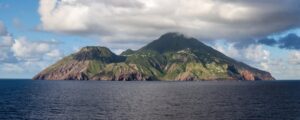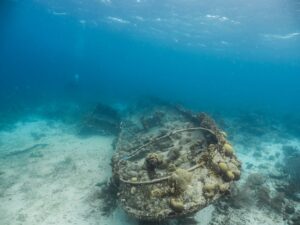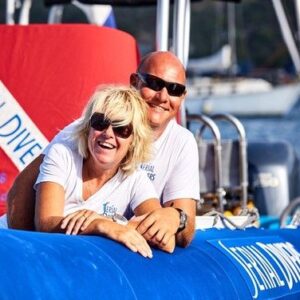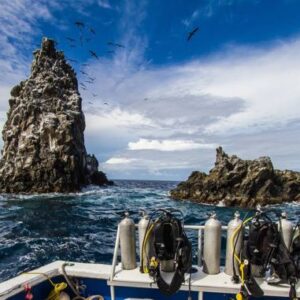Unspoiled Queen – Underwater Flora and Fauna
With its prime location in the middle of the Caribbean, the small island of Saba is known as the “Unspoiled Queen” of the Caribbean. This beautiful island boasts stunning scenery, friendly locals, and some of the best underwater in the Caribbean. In 1987, the Sabans established the Saba National Marine Park which surrounds the whole island. Diving in Saba can be characterized by three different diving types: seamounts and pinnacles, fringing reefs, and true coral reefs. Currently, three diving shops offer diving adventures and visitors must use one of them when scuba diving Saba. With only thirty maximum divers out on diving adventures at a time, Saba offers a unique and individualized experience.

GETTING THERE
Air: Saba is accessible to travelers via a 12-minute flight aboard a Winair 19-seater from St Maarten. Four flights are available daily.
Ferry: A 90-minute ferry service between the islands departs daily on alternating days.
GETTING AROUND
Saba has a solitary main road named “The Road.” The Road links the four main villages on the island.
GOOD TO KNOW
Country: Special municipality of the Kingdom of the Netherlands
Time Zone: Atlantic Standard Time (AST) (-4 GMT)
Primary Language: Dutch is the official language, but English is widely spoken across the island.
Currency: US Dollar
Cell Phone Service: Roaming charges apply.
Voltage: 110V
Passport and Visa: Travelers must have a passport valid for 3 months beyond the date of entry into the country. Saba requires a return airline ticket and proof of lodging or hotel confirmation when entering the island.
Hurricane Details: Hurricane season runs from the beginning of June until the end of November. Saba is considered within the hurricane belt.
DIVE CONDITIONS
Water Temperature: 77-84 Degrees F
Water Visibility: 60 feet to Unlimited
When to Go: Saba is a year-round diving destination.
Diving Difficulty: Beginner-Advanced
TOP DIVE SITES IN SABA
Saba caters to the diving enthusiast! Listed are some of the very best that this island can offer divers:
- Michel is located where two pinnacles rise to within 100 feet of the surface. A vertical wall is found off the taller pinnacle which slopes and connects to the other. Divers can visit and interact with the resident Hawksbill turtle.
- Third Encounter is located at the eastern end of the horseshoe shaped seamount. In July 2008, Sport Diver Magazine voted this dive as one of the 10 best dive sites. Divers can expect to see Nassau grouper, creole wrasse and creole fish, yellowtail snappers, and Caribbean reef sharks.
- Twilight Zone is a series of rocky outcrops with shallow peaks at 80 feet. The reef sharply plummets with dramatic drop offs where divers can see tiger or yellowfin groupers and Caribbean reef sharks. The sandy bottom is home to nurse sharks.
- Outer Limits is a narrow ridge with a dramatic vertical drop off. Divers will enjoy chromis and creole wrasse. Often during the right season, juvenile smooth trunkfish and juvenile spotted drums can be found here.
- Shark Shoals is located about half a mile east of Well’s Bay. This isolated pinnacle offers up-close encounters with sharks such as hammerheads. This is a popular night dive since there are many unique crustaceans hiding in the crevices.
- Diamond Rock is a famous Saba landmark sitting on a flat sandy shallow bottom at 80 feet in a protective cove. This dive offers tunnels and canyons and is rich in marine life. schools of horse eye jacks, unicorn file fish, moray eels, octopus and juvenile angelfish makes this a one-of-a-kind dive. The walls are filled with small corals and sea fans. This is a great spot for snorkeling and drift dives.
- Man O’War Shoals lies in a sandy bottom at 70 feet located just east of Diamond Rock. This site has twin rocky peaks rising 15 and 20 feet from the surface. Encrusted by yellow sponges, this site offers some of the most diverse marine life in Saba. Black coral can be found here as well as the banded jawfish, sergeant majors and sand tile fish. This is the only site where divers can spot the Atlantic spadefish.
- Core Gut is located on the windward side of Saba and diving depends on the weather. Huge boulders covered in brightly colored corals make way to a full wall dive. The coral formations are like no other on the island and show off corals made in more turbulent waters.
- Hot Springs contains magma from the volcano. Gases rise through the sand in different areas and are marked by a brownish color. Divers can feel the difference in the sand temperature. Lava fingers surround patches of turtle grass around 70 feet where divers can observe flocks of green sea turtles and garden eels.
- Otto Limits is named for the diver, Otto DeVries, who could not dive the deep areas of this pinnacle due to his lack of diving experience. Roughead blennies and bearded fire worms can be found in this shallow site. Divers will enjoy interacting with the resident Hawksbill turtle and green turtles that make this site home.
- Torrens Point is a calm and protected dive site that is referred to as Saba’s Nursery. This dive is completed in less than 25 feet of water and is a fabulous site for snorkeling. Bait ball spotted and Caribbean lobsters, flatworms and great barracuda can be spotted here. The 60-foot tunnel is a popular exploration for experienced divers.
- Saba Coral Nursery works to create and grow new reefs. Established in 2015, the site uses PVC pipes and bamboo to hang new and damaged corals to recover and grow. Corals can then be planted back into the sea. The PVC pipes and bamboo often need to be cleaned and divers can help clean the areas and give back to the diving areas that they love and enjoy. Green turtles, spotted rays and southern stingrays can be seen here.
- Customs House has sloping shallow reefs at 65 feet with a fabulous sandy bottom that is home to garden eels and both southern and rough tail stingrays. Due to the distinctive rectangular shape, this site is often described as a loaf of bread. Drooping sponges and gorgonians can be found here as well as a coral encrusted anchor from an old cargo boat. Reef sharks often pass this site. This site is located in Ladder Bay. The shore here is very rocky and until the port was built, locals would unload boats and carry cargo up the steps to the village above. The steps are so steep that they resemble a ladder.
- The Needle is one of the five pinnacle dive sites on Saba Island. This impressive pinnacle or seamount is an underwater mountain that does not reach the surface. The pinnacle resembles a needle and sits at 90 feet and encrusted with corals and sponges. Surrounded by 150 feet of water, divers can expect to see large schools of horse-eye jacks, mantas, nurse sharks, and reef sharks. If diving between January and April, divers can hear the beautiful songs of the humpback whales calling to each other. This is a perfect area for open water dives.
- Tent Reef is a perfect night dive with lobsters, octopus, and nocturnal marine life. This reef contains four different dive sites, one being Tent Reef Wall which drops 80 feet. The area is home to large patches of turtle grass where green turtles graze. Through the coral gardens, divers can see seahorses and sharp tail eels.

TOP ATTRACTIONS IN SABA
Saba’s land sites sit within four small villages: Hells Gate, Windwardside, St John, and The Bottom. The airport is in Hells Gate. Windwardside is the center of tourism with many hotels and restaurants. The village of St John is home to most of the 2000 residents on the island and where the school is located. Saba’s capital is in The Bottoms where most all the government offices are located. The last stop on The Road is the village of The Harbor. Each village holds distinct dialects and personality, and all are worth a visit.
- The Dutch Museum is a private museum located in a classic Saban gingerbread cottage. This four room house features furniture, dishes, tiles, lacework, porcelain, crystal, paintings, and books that date to the 1600s.
- Harry L Johnson Museum focuses on Saba Island and its history. It is in a sea captain’s 19th century cottage and features furniture, dishes, and artifacts from the Amerindian archeological sites on the island. Highlights include photographs and dining table set with 19th century Wedgewood China. The museum is surrounded by a beautiful, Dutch flowering garden.
- Mt Scenery is a dormant volcano and is officially the highest point on the island. Located just outside the village of Windwardside, visitors can hike this 2,700-foot mountain. The hike contains 1000 steps that have been chiseled out of the cliff.
- Wells Beach is a small black sand beach that is one of the best spots on the island for swimming and snorkeling.
- Jobean Glass Art Studio is located on Booby Hill. Jobean works out of her studio and helps visitors melt glass into balls before making beads of all shapes and sizes.
- Cove Bay is one of two ocean swimming and snorkeling spots on the island. Large boulders surround the bay which keeps currents calm.
- Flat Point Tide Pools contain several rock pools of varied sizes. These pools are wedged between the ocean and the cliff face. Visitors can explore the different pools and the creatures that live in them.
Saba gives divers a highly personalized adventure. All diving must be done with one of the three licensed diving centers on the island. Each dive center work from small boats so that there are only thirty or less divers in the water at one time. Dives are customized for the diver’s skill, interests, and desires.
This volcanic paradise has a rich quality of marine life. Beautiful reefs, impressive drop offs, caves and tunnels, and spectacular underwater formations from volcanic activity, the Unspoiled Queen Saba will entice divers to this top diving destination.










